Meeting of Disciples and friends of SDG
The Veterans of Foreign Wars Hall
845 Hudson Avenue
Stuyvesant Falls, New York 12174
There is plenty of parking near the Hall. The facility is just a few minutes’ walk from SDG’s home at 909 Albany Ave.
10:00 – 10:30 A.M. Kirtana
10:30 – 11:00 A.M. Presentation by Satsvarupa Maharaja
11:15 – 12:30 P.M. Book Table
12:30 – 1:15 P.M. Arati and kirtana
1:15 — 2:15 P.M. Prasadam Feast
Baladeva Vidyabhusana at [email protected] or (518) 754-1108
Krsna dasi at [email protected] or (518) 822-7636
SDG: “I request as many devotees as possible to attend so we can feel the family spirit strongly. I become very satisfied when we are all gathered together.”
******
Śrī Caitanya-caritāmṛta, Madhya-līlā 20.124–125: “O great learned devotee, although there are many faults in this material world, there is one good opportunity—the association with devotees. Such association brings about great happiness. . . . .”
Srila Prabhupāda: “Therefore, our Society is association. If we keep good association, then we don’t touch the darkness. What is the association? There is a song, sat-saṅga chāḍi’ kainu asate vilāsa, te-kāraṇe lāgila mora karma-bandha-phāṅsa (Gaurā Pahū, verse 3). Sat-saṅga. Sat-saṅga means association with the devotees. So the one poet, Vaiṣṇava poet, is regretting that, ‘I did not keep association with the devotees, and I wanted to enjoy life with the nondevotees. Therefore I’m being entangled in the fruitive activities.’ Karma bandha phāṅsa. Entanglement.” [Conversation with David Wynne, July 9, 1973, London]
Before beginning japa, I heard a tape of Dravida reading Bhagavad-gita As It Is. He read the verse that one should approach a spiritual master and inquire from him submissively. The self-realized soul can impart knowledge unto you because he has seen the truth. Prabhupada says one has to pass the test of the spiritual master. One cannot just ask absurd inquiries but must accompany his questions with submissive service. The spiritual master has to come in disciplic succession and not manufacture teachings. This is a good verse to begin chanting japa because the third offense is to disobey the order of the spiritual master.
******
By the time I reached four rounds, I was alert and focused on counting. I was also taking shelter in the potency of nama bhajana. That is, I left behind other things and simply absorbed myself in japa. As I continued, it didn’t get better, but I stayed exactly on course, not wavering in my attention on the holy names. I certainly hear the syllables and stay awake with trust in the process. It is working, even though I don’t go deeper. I long for the day when I will feel emotions as described in Siksastakam.
******
I received a letter from a Godbrother lamenting that he does not have access to taking part in kirtanas. He cited a statement by Srila Bhaktisiddhanta Sarasvati Thakura:
“Proper japa chanting is possible only in the mind. Then the chanter will achieve the desired perfection. Chanting audibly with lip movements is kirtana; it is more effective than japa and brings about the greatest benefit to the hearer. Sankirtana means ‘complete kirtana,’ for it is unnecessary to perform any other devotional activities if one performs sankirtana” (from Srila Bhaktisiddhanta’s purport to the first sloka of Sri Siksastakam).
My Godbrother wrote, “I know philosophically that the holy name is no less potent in japa than in sankirtana, but the issue is not Sri Nama’s potency; rather, it is my ability to be absorbed. . . .”
******
Dear Lord,
let me address You and be in a
Krsna conscious poem.
I know You want devotion and nothing
else pleases You.
But that’s the one ingredient
I can’t muster up.
How to make this poem?
I recite the words Krsna, Krsna,
Hare, Hare, as in my own japa,
not with devotion but the thing itself
the holy names, the humming
of the holy names, nothing else.
I offer too my breath and effort.
I keep trying to hear but not
trying enough. Until the end
I am not the best.
Lord, You are the sole creator.
Everyone creates after You.
I have read of You in the sastra
and heard from Your pure devotee.
He really believes in You and convinced me
and thousands of others. Now we form
a movement trying to convince people.
Let it convince ourselves first,
more chanting, more preaching.
I am in there, a little one, in there,
Lord, Your books Gita and Bhagavatam
are great and I’m studying the Caitanya-caritamrta.
Please bless me to speak of You
to hear of You
to serve in parampara,
to know You
as the original person,
my best friend of all.
Hare Krsna.
******
My mind has not been wandering but has been staying fixed on the utterance of the names, so I’ve come to expect this. It’s a gain from my previous years’ chanting. My chanting of eight rounds was below seven minutes a round. Aside from hearing the sounds of the syllables, my mind did not sink into a Radha-Krishna meditation. But I am calling out just by basic faith in the japa operation. I have confidence in Krishna’s being open to me when I chant japa. My fixation on accumulating mantras is not the highest stage, but it is important work. For now, it is the heart of my practice. I pay attention and quickly add one mantra to the next. I try to do something besides counting. This morning I thought of the vintage Lough Derg diary I’m reading, and I was eager to read some more. Aside from this, I could not think of Krishna aside from the counting. After all, Prabhupada did advise, “Just hear.”
******
The Names are absolute. You benefit just by touching them with your tongue. When you put your hand in fire, you’ll be burnt. When you say the Hare Krishna mantras, you become Krsna-ized.
******
When I chant in the mind, I think it’s due to fear of overstraining (and getting a headache), or maybe it’s laziness. But I remain attentive. Prabhupada said we should cry like a child calling for its mother. That is a wonderful quality. He said Mother Hara (Srimati Radharani) would hear our cry and respond with Her mercy. Am I crying, at least a little? I think so.
pp. 37-39
There was a big crowd of people waiting as we disembarked in Tokyo airport, but they weren’t there to greet Srila Prabhupada. Some of them held up signs to attract the attention of persons they were looking for, and they glanced past Prabhupada with no interest. The people waiting were almost all Japanese, many of the men dressed in Western suits and ties, but soon we saw an American sannyasi, dressed in saffron and carrying a danda. I had never met him but knew he must be Gopala Swami, who I heard had only recently arrived in Japan. He approached Srila Prabhupada, holding his palms together in obeisances, and then told us he had a car waiting.
Prabhupada’s first words were, “Where is Trivikrama Swami?”
Gopala Swami said, “He has gone to Korea.
Prabhupada seemed uneasy about the absence of Trivikrama, whom he had expected to be preaching here and greeting us. He said no more as he followed Gopala through the crowded airport to the parking lot while Panditji and I struggled along behind, each carrying two briefcases and two or three bulging shoulder bags.
As we rode in a small car with Prabhupada through the congested city, Prabhupada asked me, “Is this your first time in Japan?” I replied, “Yes.” I was grateful that he had asked. Although he had so many higher things to consider, he took time to make such an inquiry from an insignificant servant. From the car window we could see factory buildings on both sides and everywhere heavy traffic of small automobiles and pedestrians. The weather was cold—no more beaches and palm trees.
“These Japanese workers,” Prabhupada said, “are all simply karmis involved in a fruitless pursuit.” Gopala Swami told how he had recently come here to stay with the few Western devotees maintaining a small house in the city. Some Japanese youths were coming, but the preaching was difficult because the people were so materialistic.
Prabhupada reassured him that results would come if they persisted and distributed books. He mentioned that Sudama, who had been the first to come to Japan on Prabhupada’s behalf, had had some success and had even started learning the Japanese language, until he had grown restless and left.
We had planned to stay in Tokyo for only twenty-four hours. Gopala Swami took us to the house and showed Prabhupada his room, which was very tiny, like most places in Japan. It was the master bedroom, the largest room in the house, but it was maybe one-fifth as big as Prabhupada’s room in Hawaii, and there were no windows. There were four devotees living in the house, and they greeted Prabhupada, although not with a kirtana. Gopala said there was one boy, an initiated disciple of Prabhupada, who was not living at the temple but who was anxiously pressing to meet with Prabhupada and ask him questions. Prabhupada agreed to see him, and within a few minutes of our arrival, while I was still unpacking Prabhupada’s briefcases, a young American man, dressed in Western clothes, entered Prabhupada’s room, offered obeisances and sat before Prabhupada with a troubled look on his face.
Prabhupada was wearing a sweater, with his cadar wrapped around him in the chilly room.
“Why don’t you live with us?” Prabhupada asked.
I got a good inside glimpse of Prabhupada, both as a world-traveling sannyasi ready to go anywhere, and as the supreme troubleshooter and maintainer of the devotees in ISKCON.
“I am not able to be free living within this movement,” the discontented disciple replied.
“Where are you living?” Srila Prabhupada asked. There were just a few of us in the room, but it was crowded. I was suffering somewhat from culture shock and from the discomfort of traveling, and it all made me take shelter in Prabhupada more than usual. But I couldn’t understand why Srila Prabhupada had to immediately deal with this unsubmissive boy.
“I am living in the train station;’ he said.
“The train station?” asked Prabhupada. “What is that like?”
The young man began describing his difficult life in the train station. The policemen would often wake him up and throw him out by force.
“So you have left us in order to have more freedom;’ said Prabhupada, “But now you are living under force!’
“Yes.”
“If you do not like living with devotees,” Prabhupada continued, “you will find it even more difficult living under the strict control of the material nature. So give this up and live with us.” But the boy remained reluctant, expressing a vague grudge and a misguided philosophy.
pp. 297-99
Jane decided to change her tactics. Rather than try for the clean- slate approach, she decided to accept Mr. Barks as a more “normal” person and go on from there. She told him she wouldn’t tolerate any drinking, smoking, cursing, or womanizing. But they could loosen up a little. She let him wear his old skinhead haircut and his regular clothes, a T-shirt revealing all his tattoos. After all, she also had a tattoo. Hers was an empty heart. She thought someday she’d fill it in with the name of the man she loved. But now she was thinking she would fill it in with the words “Gaura-Nitai.” She started rolling him in his wheelchair outside the sanatorium on sunny days and calm evenings, and playing a guitar to him and letting him sometimes play the guitar. They would sing old, old Bob Dylan songs and other folk songs, and any songs they knew. Some of the inmates thought they were getting romantic, but she told them it was just a clinical approach. She knew what she was doing. It certainly made Mr. Barks cheer up. She told him he didn’t have to use the name “Mr. Barks,” and asked him what he would like to be called. He thought it over for a day and then said, “‘Barks’ would be all right.”
One sunshiny day she took him for a ride in his wheelchair into a nearby park. As they came into a woody, secluded part, they were approached by three tough-looking skinheads. Immediately the men became aggressive without any cause. “Hey,” one of them said, “look at this pseudo-skinhead in a wheelchair and his phony tough dame.” The middle man kicked Barks on the chest with his boot and knocked the wheelchair over. Barks hit his head on the ground. Jane became enraged. She ran around the back of the wheelchair and righted it. Barks then stood up, and with a haymaker punch slugged the middle man on the chin and knocked him to the ground, unconscious. Jane then did her favorite karate move, the punch with the heel of the hand under the nose and then into the groin. That man then screamed and limped off into the woods. The third man didn’t need any warning but ran off unharmed. Barks sat down heavily in the wheelchair. Almost immediately, a police car pulled up. The cop rolled down his window and said, “We saw what happened. You people are from the Hare Krsna sanatorium, right?”
“Yes,” said Jane, “and this man in the wheelchair had a bad motorcycle accident that made him lose his memory. Now he may have a relapse.” Barks sat slumped in the wheelchair. He looked dazed. The cop said, “We’ll go round up those culprits. You just go back to the sanatorium. Ya did a pretty good job of self-defense. Congratulations.” While Jane turned and guided Barks and his wheelchair back to the sanatorium, the cops drove into the woods, having already handcuffed the unconscious man and put him in the back of the car. It didn’t take them long to fmd the man who had been karatied lying on the ground nursing his pains. But they had to drive far before they found the third man running fast down the street and finally ducking into a tavern. The police went into the tavern with their guns drawn and came out with another handcuffed culprit.
Jane brought Barks back to the sanatorium and put him into bed. He was a little disoriented. The cops dropped by and congratulated them on what they had done and said that all of the men would be charged with assault, and that they had nothing to worry about. They said that anytime they needed help, they should ask for it. As the cops were leaving, Barks looked up and asked, “Where am I?”
“You’re here safe in the sanatorium,” Jane said gently. Barks began to smile. “We just had a good fight, huh?”
Jane smiled without speaking. Barks said, “Would you marry me?”
“If you’re feeling that good, then I think you should be able to chant on your beads. Here they are,” and she put them on his lap. “We can talk about other things later.”
pp. 298-300
Although it makes sense to purchase airline tickets or make hotel reservations through reputable firms, when tour companies try to give spiritual instructions, let the customer beware!
For example, Indrama, a magazine for tourists to India, recently carried a lead article titled “The Indian Trinity.”
Philosophical exploration is one aspect of man’s search for a solution to the riddle of existence. The other and more fascinating is poetic legend. It is the second which gave birth to Hindu mythology. Symbolic ideas gain precision when the Deity is given form, says the author.
The telling phrase here is “says the author.” In this case, the author has no credentials as a spiritual teacher or practitioner, but he gives his opinion that God is a myth. Of course, impersonal and atheistic interpretations of Vedic scriptures existed long before the tourist business, so we cannot blame Indrama for presenting the popular misconception. They are simply trying to live up to their slogan, “India packaged for you!”
But what do the Vedic scriptures actually say about “The Indian Trinity”? Is it true that when the scriptures portray God as a person it’s to be taken as a mythological, poetic invention? Are the accounts of Vishnu, Krishna, Siva, and Brahma only make-believe? Is the ultimate truth something beyond personality? The author of “The Indian Trinity” article holds the opinion that God is poetic myth, but the Vedic scriptures do not. Sri Krishna, declared throughout the Vedas to be the Supreme Personality of Godhead, specifically addressed this subject in the most authoritative and widely read Vedic scripture, Bhagavad-gita (7.24–25):
Unintelligent men, who do not know Me perfectly, think that 1, the Supreme Personality of Godhead, Krishna, was impersonal before and have now assumed this personality. Due to their small knowledge, they do not know My higher nature, which is imperishable and supreme. I am never manifest to the foolish and unintelligent. For them I am covered by My internal potency, and therefore they do not know that I am unborn and infallible.
Thus, the scriptures declare that God has unlimited eternal, blissful forms. In His original form in the spiritual world, He is Krishna or Vishnu. And when He expands as demigods to perform the administrative work of managing the material universe, He is Siva or Brahma. This viewpoint is held by all the acaryas, or teachers of the Vedas, who accept the Vedic scriptures as perfect guides for spiritual knowledge and who have written learned commentaries that guide the spiritual destiny of India. Therefore, persons who want to find the hidden treasures of India’s spiritual life should go to these direct sources: the scriptures and their authorized guides.
You can dovetail the desire for sightseeing in India with a desire for spiritual knowledge if you follow bona fide guides and stop at spiritual centers, such as the ISKCON temples located throughout India. ISKCON’s Krishna-Balaram temple in Vrndavana, the site of Krishna’s pastimes and one of India’s most important spiritual places, is only an hour from Agra, the site of the Taj Mahal. So, you can visit Krishna’s birthplace either before or after your tribute to the Taj. Thousands of architecturally charming Krishna temples grace Vrndavana, and ISKCON’s guesthouse offers comfortable accommodations along with an experience of genuine spiritual life. Devotees at ISKCON’s Vrndavana center hold continuous melodic chanting of the Hare Krishna mantra: Hare Krishna, Hare Krishna, Krishna Krishna, Hare Hare/ Hare Rama, Hare Rama, Rama Rama, Hare Hare. And even if you can only stop briefly, you can enjoy eating krishna-prasadam (food offered to Lord Krishna) at ISKCON’s purely vegetarian restaurant.
Another important spiritual center is the birthplace of Lord Caitanya, in Mayapur, West Bengal. Writers have described rural West Bengal to be the most beautiful natural scenery in all of India. The ISKCON temple there includes a 3-acre garden, a 25-foot-tall fountain, a natural-environment zoo, large and comfortable guesthouses where delicious Bengali-style vegetarian cuisine is served, and association with ISKCON devotees from around the world. The Mayapur temple draws 1,500 tourists weekly, most of them coming especially to see the Deity forms of Radha and Krishna and to bathe in the Ganges, just a short walk from the temple.
At ISKCON centers in cities such as New Delhi, Mumbai, and Chennai, you can experience India’s urban life and at the same time get in touch with the eternal wisdom of the Vedas.
If you’re inclined to hiking and roughing it, you can join the ISKCON pada-yatra, a walking pilgrimage that has been traversing India for two and a half years. The pada-yatra, with its ox-drawn cart and pet elephant, is currently making its way to Badrinath, high in the Himalayas. Spiritually-minded walkers are always welcome.
pp. 212-14
Any suggestion that an ISKCON devotee should “see a psychiatrist” used to be taken as a first-class invitation to maya. But there is a growing acceptance that some devotees are handicapped by their past karma to such a degree that they can’t function well as bhaktas or bhaktins. Despite their sincerity, they are dysfunctional. And so, we have the phenomenon of devotees going to see counselors, psychologists, and so on. It is a dangerous thing, however, if a devotee goes to see someone who is not a devotee or is not entirely sympathetic to the devotee’s following the four rules and chanting sixteen rounds, or to a devotee’s single-minded dedication to Srila Prabhupada.
Admitting that there is a place for psychotherapy in the life of certain candidates for Krishna consciousness, I would caution that it should be used only as a secondary resource, or only for those problem cases where sincere persons are not able to function normally with other devotees because of their traumatic situation. Srila Prabhupada said that the routine life of Krishna consciousness was healthier than the life of the meat-eating, intoxicant-taking karm?, and therefore devotees would be not so likely to run up big medical bills. It seems also true that the regulated life of Krishna consciousness will take care of mental health without separate therapy provided by a professional psychologist.
I thought it would be interesting to make a list of the symptoms of good mental health and see whether they are naturally attainable within the life of Krishna consciousness. A psychiatrist who is presently treating an ISKCON devotee gave me a list of four standard items of mental health. She said that if any of these four needs are not fully met, there will be some mental imbalance.
In other words, there is a crucial relationship between physical health and mental health. Speaking for myself, I know that I was practicing poor health habits before I joined Prabhupada in New York City in 1966.
I was living alone, not cooking for myself but eating junk food, smoking, and doing other things that we deleterious to good physical health. Right after coming to Srila Prabhupada, I noted that my physical health improved just by engaging in the natural Krishna conscious activities he gave us, partaking of the wonderful prasadam he cooked, participating in the new “physical exercise” of dancing, and completely eliminating smoking and illicit sex. (I am still amazed at how quickly I was able to give up those bad habits, by his divine grace.)
Critics of spiritual life sometimes accuse the devotees of not taking care of themselves physically, but it was not the intention of our founder-acarya that his disciples neglect their physical health in the name of spiritual advancement. Prabhupada writes; “In the past, great authorities selected those foods that best aid health and increase life duration, such as milk products, sugar, rice, wheat, fruits, and vegetables” (Bhagavad-gita 17.10, purport). And Krishna Himself states in His instructions to Uddhava:
“One should endeavor to get sufficient foodstuffs, because it is always necessary and proper to maintain one’s health. When the senses, mind and life-air are fit, one can contemplate spiritual truth, and by understanding the truth one is liberated.”
—Srimad-Bhagavatam 11.18.34
In the Age of Kali, it is becoming harder and harder for people to find minimum food, clothing and shelter. The devotees don’t overendeavor to get these basic physical necessities, but their experience is that Krishna always fulfills these minimum physical needs so that they can execute their spiritual life. At least we are no worse off than the nondevotees who work day and night just to increase the luxury and security of their food, clothing and shelter.
pp. 13-16
You appear a little restless,
I know that is your nature.
But you needn’t look further
to find some big challenge.
The challenge is near at hand.
Suppose I am established as a good carpenter,
then it will be foolish if after some time
I say, “Oh, I have done this cutting of woods,
now it is boring, let me become a doctor.”
Krsna doesn’t want that,
and it is not common sense.
I should stick to one duty
which is just suitable for me,
and consider throughout my life
I am obliged to perform it
to the best of my ability,
and not leave it
even for a so-called good cause,
as when Arjuna wanted to stop fighting.
We are preachers on behalf of Lord Krsna—
that is our occupational duty.
We don’t have to search further
for a new challenge or change.
It has already been settled.
So the best thing will be
to develop more and more
what we have begun.
And there is so much to do:
I have built the skeleton
of the building,
but there is much more work
remaining before us.
—Letter of 2 January 1973
You have a desire
to become a famous preacher
and a famous Vaisnava singer
and also jagat-guru.
This is a spiritual desire.
But “famous Vaisnava” means
that you have no sex desire.
Whether you can be like that?
First be without any sex desire,
then think “famous Vaisnava.”
—Letter of 31 December 1972
Krsna consciousness means
we should always be satisfied and happy;
not that we must work something impossible,
become overburdened and then,
because we are unhappy by so much trouble,
we lose enthusiasm and give up all hope.
By all means we must preserve
our spiritual status, that is the point.
Not that we are mad after big buildings,
many devotees, life members, this, that—
no. These are only ways to engage the devotees,
so that they may apply the principles
of devotional living to some kind of work.
It is not the result of the work we want.
If we sincerely preach
to only one person in a day,
that is sufficient,
never mind big, big programs.
So do not be bothered by these things.
Krsna does not like to see His sincere devotee
suffer or become frustrated or depressed.
He will not stand idly by in such case,
so do not fear on that account.
Krsna has some plan for you,
always think in that way
and very soon He will provide
everything to your heart’s desire.
—Letter of 9 December 1972
“Honolulu
May 23, 1976
“Los Angeles
“My dear Satsvarupa Maharaja,“Please accept my blessings. I am in due receipt of your letter dated May 19, 1976 as well as your copies of two purchase orders from two universities for the Bhagavad-gita As It Is.
“The public libraries can order many sets, 50 to 100 at a time, for all their branches. Your tactics sound very good. The Indian professors’ reviews can be used to stimulate American orders, and the American professors’ reviews can be used to stimulate orders in India. So now with so many testimonials, why these libraries will not purchase?
“The scientists cannot make a machine from a seed. Why not? Can they make a typewriter machine tree, or an automobile tree, that you plant a seed and you get an automobile . . . it gets bigger, bigger, bigger until it is a full size automobile. They cannot make even one egg, and they are going to manufacture life? And we have to believe it? They are lunatics, this is demoniac. They want to compete with God.
“Concerning the Deities in Chicago temple, if you want to have large-size Gaura-Nitai, then I have no objection. Your new traveling mobile temple sounds very nice. I shall be glad to see it when I visit Detroit. Keep yourself comfortable so that you can work nicely. There is no need of dry vairagya.
“I hope that this meets you in good health.
“Your ever well-wisher,
“A.C. Bhaktivedanta Swami”
This letter focuses on Prabhupada’s desire that the Library Party place many of his books in the public libraries. We were able to do this in all the universities, but we were not successful in selling his books to the public libraries. They had their own method of putting books on their shelves, and we could not use our process that had worked so well in the colleges and universities.
Prabhupada writes about the “lunatics” who say they can manufacture life from matter. He asks if they can make a typewriter or an automobile from a seed, will you get a full automobile in time? He says those who put forward this “life comes from matter” belief are lunatics and demonic—“They want to compete with God.”
Prabhupada approves of the Chicago temple installing Gaura-Nitai Deities. He also says my new traveling mobile temple sounds very nice; he will see it when he comes to Detroit. He actually came and saw our RV vehicle. He boarded it, saw the Gaura-Nitai Deities and bowed down to Them. His point is nice and assuring: “Keep yourself comfortable so that you can work nicely. There is no need of dry vairagya.” I was happy to hear that Prabhupada wanted us to be comfortable in our new vehicle. There was no need of dry renunciation. This was his advice to sannyasis in 1976: his men should be comfortable so that they could work nicely.
This sadhu goes public with his
private thoughts
anomalies exposed.
He knows that either we have to say,
“We should, we
should,
because our leaders
are perfect
and we believe everything
perfectly”
or some other sickness
or we have to be
who we are
and pray from there.
There’s a way to enter the
fragrance before dawn arrives
to enter mystery and to improvise
a response.
It takes training
and the willingness to bring any story
to its natural conclusion: the meeting
with your master
as if all roads really do lead to Rome
where a Pope stands on his balcony
and blesses the crowds regardless.
We have wasted so much time
joyriding, poor boy
spilling fluids
and life
into temporary moments
irreligious, imperfect.
Today is my master’s disappearance.
I should be mourning but I am not I’m
singing instead like a rose bedewed
in predawn softness
in a room with curtains closed
after a peaceful night at Inis Rath
sensing the fragrance of spiritual life
its power
the life lived by one
who can do nothing without his master
and who relishes the quiet of morning before sunrise
even today.
Sound preserved—music and words.
Prahlada teaches us what’s to come. We could
waste our time on any variety of things if we put
our minds to it. But I know what it feels like to let go
on my trip to the shore of eternal gain.
Still the question: Why didn’t I do more?
But let go of lament—hold the beads and sing.
What other novelty and lasting grace?
I barricade myself against my failures and chant.
There’s rarely time for writing between poems—my
self demands more reading time.
It’s like he’s saying, “What good
will your three-minute speech do?” If I read one page
of Prabhupada’s books
I can become perfect.
Janmastami is less than a month away. I
read the prayers the demigods spoke to
Krsna in the womb.
The demigods sometimes prayed to Krsna
on His way home from the pastures. He was
always polite, but His parents felt the anxiety
of His delayed return.
I suddenly thought I knew better prayers
than these, as if I were better than them.
Does Krsna trust me to run the universe?
Do I serve the Divine Couple as well as the sun-god?
Can I glorify Vraja as Lord Brahma can?
How rare is bhakti.
These thoughts come out in poems and I dump
the images onto the page like apples out of a bag.
Still, the truth is simple.
This collection of Satsvarūpa dāsa Goswami’s writings is comprised of essays that were originally published in Back to Godhead magazine between 1966 and 1978, and compiled in 1979 by Gita Nagari Press as the volume A Handbook for Kṛṣṇa Consciousness.
This second volume of Satsvarūpa dāsa Goswami’s Back to Godhead essays encompasses the last 11 years of his 20-year tenure as Editor-in-Chief of Back to Godhead magazine. The essays in this book consist mostly of SDG’s ‘Notes from the Editor’ column, which was typically featured towards the end of each issue starting in 1978 and running until Mahārāja retired from his duties as editor in 1989.
This collection of Satsvarupa dasa Goswami’s writings is comprised of essays that were originally published in Back to Godhead magazine between 1991 and 2002, picking up where Volume 2 leaves off. The volume is supplemented by essays about devotional service from issues of Satsvarupa dasa Goswami’s magazine, Among Friends, published in the 1990s.

“This is a different kind of book, written in my old age, observing Kṛṣṇa consciousness and assessing myself. I believe it fits under the category of ‘Literature in pursuance of the Vedic version.’ It is autobiography, from a Western-raised man, who has been transformed into a devotee of Kṛṣṇa by Śrīla Prabhupāda.”
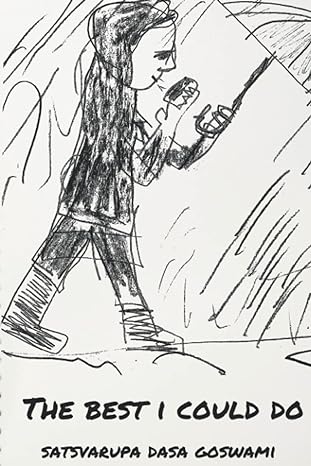 The Best I Could Do
The Best I Could DoI want to study this evolution of my art, my writing. I want to see what changed from the book In Search of the Grand Metaphor to the next book, The Last Days of the Year.
 a Hare Krishna Man
a Hare Krishna ManIt’s world enlightenment day
And devotees are giving out books
By milk of kindness, read one page
And your life can become perfect.
 Calling Out to Srila Prabhupada: Poems and Prayers
Calling Out to Srila Prabhupada: Poems and PrayersO Prabhupāda, whose purports are wonderfully clear, having been gathered from what was taught by the previous ācāryas and made all new; O Prabhupāda, who is always sober to expose the material illusion and blissful in knowledge of Kṛṣṇa, may we carefully read your Bhaktivedanta purports.
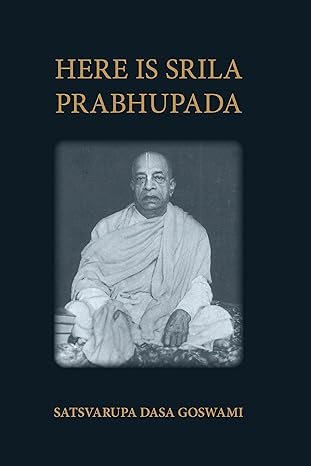
I use free-writing in my devotional service as part of my sādhana. It is a way for me to enter those realms of myself where only honesty matters; free-writing enables me to reach deeper levels of realization by my repeated attempt to “tell the truth quickly.” Free-writing takes me past polished prose. It takes me past literary effect. It takes me past the need to present something and allows me to just get down and say it. From the viewpoint of a writer, this dropping of all pretense is desirable.
 Geaglum Free Write
Geaglum Free WriteThis edition of Satsvarūpa dāsa Goswami’s 1996 timed book, Geaglum Free Write Diary, is published as part of a legacy project to restore Satsvarūpa Mahārāja’s writings to ‘in print’ status and make them globally available for current and future readers.